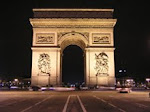Thursday, March 4, 2010
Introduction
The form of the arch has endured thousands of years, from its first emergence in Roman antiquity to its modern-day usage in both architecture and the other arts. The arch has enjoyed such a widespread and lengthy presence on the stage of history due to its formal adaptability to changing circumstances and its amenability to re-appropriation by shifting audiences. In film, specifically, the arch has been used as a flexible thematic device; it has been used by various directors to symbolize transitions, to intensify moments of suspense, and to underscore the power of certain characters. We explore three films in which directors have utilized arches to increase the impact of their films: L'Avventura (Michelangelo Antonioni), Cleopatra (Joseph L. Mankiewicz) and The Arch of Triumph (Lewis Milestone). We argue that whether the arch is used as a blatant symbol of power (as in Cleopatra) or as a subtle reflection of characters' psychological transformations (as in L'Avventura) audiences inevitably register the presence of the arch in the frame; for this reason the arch retains its relevance in film and, more broadly, in contemporary culture.
Subscribe to:
Post Comments (Atom)

No comments:
Post a Comment